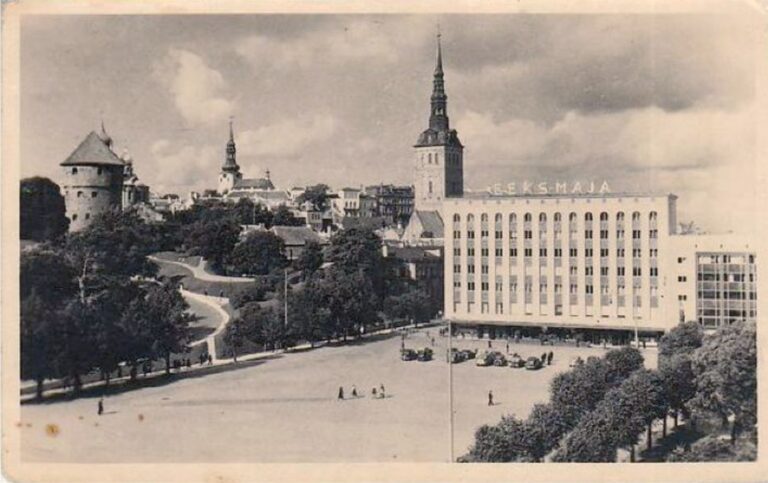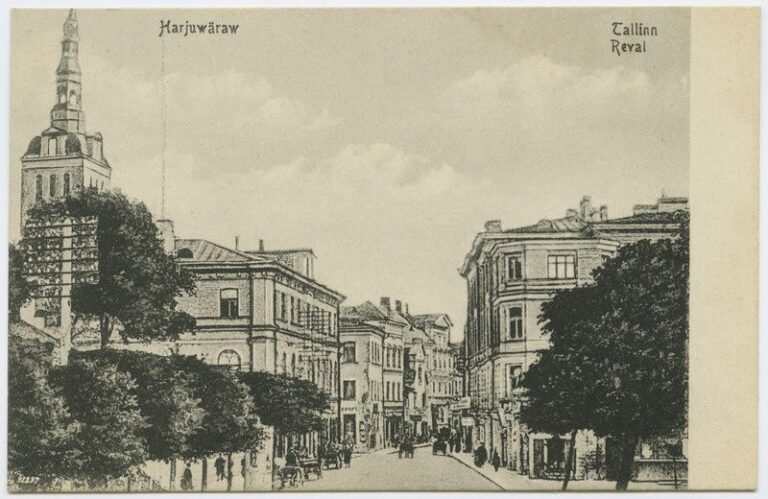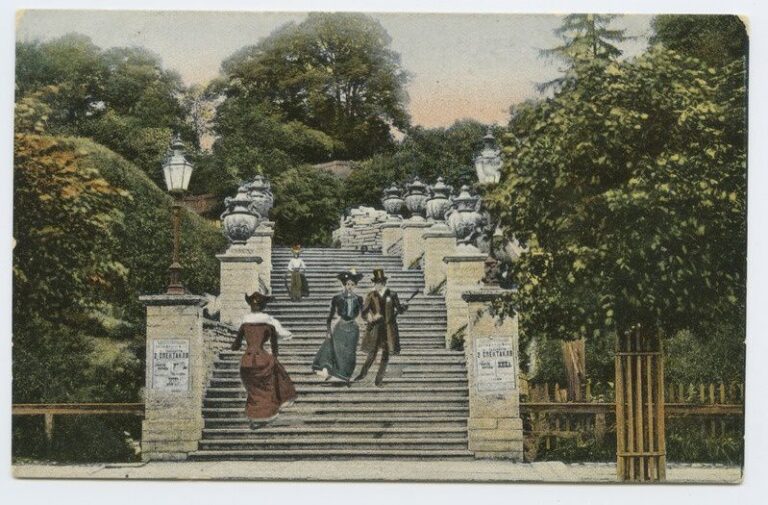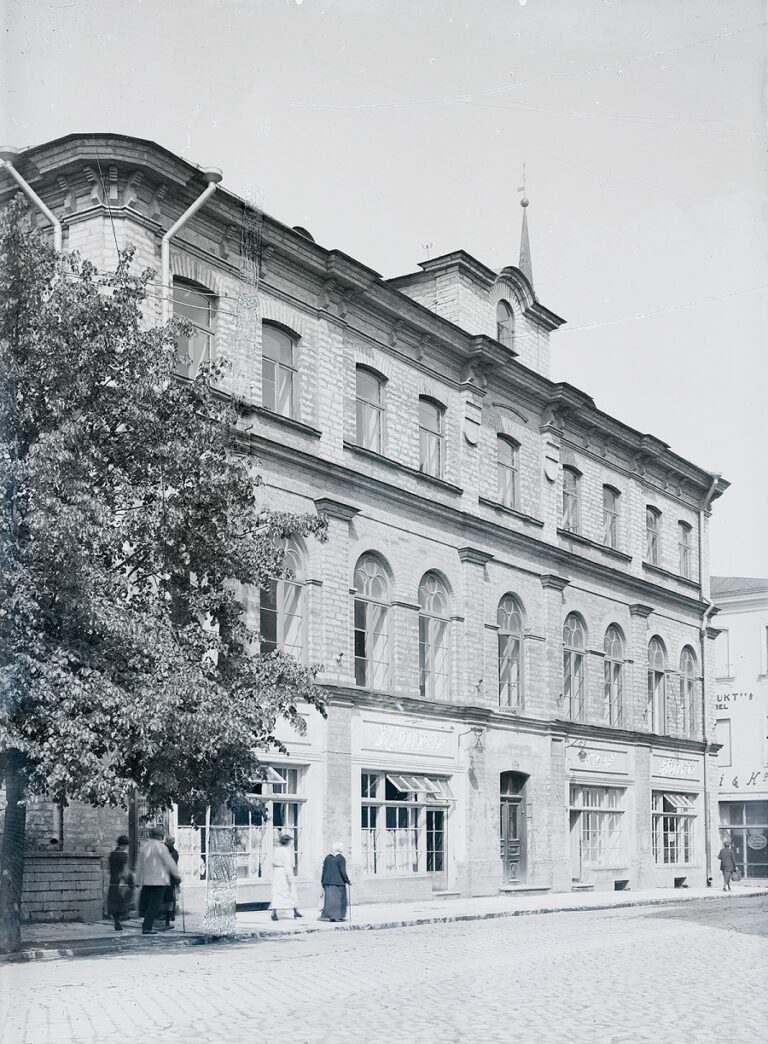History of the Building
Tallinn Business Center | Harju 6, 10130 Tallinn
Harju 6 history of the Building
The commercial building at Harju Street 6 in Tallinn’s Old Town is indeed steeped in history and carries significant cultural importance. Like many other buildings in the Old Town, it is part of the UNESCO World Heritage area, reflecting Tallinn’s rich history and architectural diversity.
The historical overview was prepared by historian PhD Heino Gustavson.
The origins of our building date back to the ancient Hanseatic city on the shores of the Baltic Sea. The city’s history extends to the second half of the 2nd millennium BCE when our ancestors established their first settlement along the coast of Revalia. As the sea receded, the settlement moved further inland, and today, we are still situated by the same coast near the mouth of the Pirita River. Throughout its long history, the city has been known by several names in records, including Lindanise, Reval, and now Tallinn. The history of this Hanseatic city would not be complete without our building and the structures that preceded it.
Early Events and Development
Significant events occurred in the mid-14th century when the moat surrounding the city began to dry up. Since the moat was not allowed to remain dry, King Valdemar IV of Denmark granted Tallinn’s City Council and citizens the right on September 29, 1345, to channel water from Lake Ülemiste into the city moat. Construction began in 1346 based on this decree, resulting in a limestone-bottomed water channel approximately 4 km long, ending just west of the Harju Gate. This created a pond, which powered a watermill built in the area.
During the Livonian War in February 1577, while Russian troops besieged Tallinn, they began digging two mine tunnels from their fortifications on Tõnismägi. In response, the city defenders likely started counter-mining under present-day Toompea Street. In March, the Russian troops retreated, leaving Tallinn a stronghold under Swedish rule in the Baltics. The mysterious underground passages remained as relics of these events.
In 1686, Swedish King Charles XI approved a fortification project for Tallinn, which included the construction of the Ingeri Bastion (commonly known as the Harju Gate Hill). The sand and soil required for its construction were brought from nearby areas. To ensure cleaner water flow into the city, the channel was later covered with a limestone vault. By 1688, city maps indicated that the channel had been vaulted. The bastion construction was completed in 1699, just before the Great Northern War, and included another vaulted passage to transport ammunition to the cannons on the bastion.
Today, visitors to the restaurant Wana Tunnel and the mulled wine bar Karoliina can explore these restored vaulted water tunnels and the so-called mine passages, which were renovated in the late 20th century.
Harju Gate and Later Developments
One of the prominent medieval structures on the site was the Harju Gate, consisting of a main gate tower integrated into the city wall and two outer gates with side towers. As the gate lost its military importance, its demolition began in 1862, with the main gate tower being dismantled in 1875. Along Rüütli Street, near Toompea, stood a small military building from the Tsarist era, which served for a time as a casino for the officers of the 90th (Onega) Division.
Following the demolition of the main gate, construction activities accelerated. In 1879, merchant Alexander Ernst commissioned architect Rudolf Knüpffer to design a three-story stone building next to the mentioned government building. The facade facing Harju Street, which was intended for shops, has been preserved to this day. The shop windows were relatively small, and there were three doors in total. The second floor featured large arched windows for luxury apartments, while the third floor, with simpler living spaces, had smaller and lower arched windows. The building was roofed in 1880, as confirmed by archival records and the decorative plaques above the main entrance facing Harju Street. The left plaque reads EDIFICATUM ANNO 1880, while the right one says No.608 II REV.ST.T. A.ERNST, indicating the plot number, district, and owner’s name.
Along with the main building, a simple granary was constructed in the courtyard against Harju Hill, and a residential building was built alongside the city wall on Rüütli Street. The granary was soon replaced by a two-story house, and at the end of the century, the new owner, Major General Baron Eduard von Maydell, received permission to add a third floor. The project was designed by architect Nikolai Thamm.
20th Century: Schools and Shops
By 1900, the building housed Marie Wellmann’s third-category private school for boys and girls. At the same time, Vitali Boroshkin operated two stores, one selling haberdashery and the other toys.
In 1913, Christian Rubin’s bookstore occupied the ground floor. In August 1917, Maydell sold the property to Wilhelm Kirstein, an innkeeper who planned to open a café on Harju Street. However, political turmoil delayed his plans, and it wasn’t until 1920 that Café Kirstein opened, based on architect Franz de Vries’ project, which enlarged the shop windows on the ground floor.
Two other notable events occurred in 1920: the first Estonian bookstore, owned by the publishing company AS Varrak, opened in the building, and Tallinn City’s Second Secondary School moved in. In 1922, the school was renamed Tallinn Technical High School, occupying the second and third floors. The beloved Estonian composer Gustav Ernesaks was among its students.
In 1922, Kirstein applied to expand the café, receiving permission to extend it to the part of the building facing Freedom Square. That same year, the arrangement of the shop doors was altered, and the shop windows were enlarged once more.
By 1923, the café had grown into a prestigious establishment with two halls and seating for 200 guests, offering sophisticated dance music in the evenings. Notably, no alcohol was sold in this café.
Galerii
The building at Harju Street 6 holds significant cultural and architectural value in Tallinn’s history, being an integral part of the rich heritage of the Old Town.





The owner continued to energetically modernize the building. In the summer of 1927, he renovated the main section facing Rüütli Street and installed central heating throughout the entire property. On September 5, 1927, he received permission from the Department of Science and Art of the Ministry of Education, which also handled heritage conservation, to “make openings in the old city wall, provided that the exterior surface of the wall remains unplastered and fully retains its historic appearance” (these openings have since been sealed again).
However, the same year proved to be a turning point for the owner, as financial difficulties struck by the end of summer. He soon ceased using the second hall of the café, closed it entirely by the end of the year, and sold the neighboring bookstore to the publishing cooperative “Rahvaülikool” (People’s University). At the new owner’s request, both schools vacated the building, and the entire property was acquired by the Merchants and Industrialists’ Association, which opened a restaurant called “Küba” in the main building in 1928. The association also rented spaces to the Property Owners’ Bank (formerly North Estonian Cooperative Bank) and K. Glaser’s shoe store. Due to public amusement over the unusual restaurant name, it was soon rebranded as “Savoy.”
In 1929, permission was granted to build an external staircase on the south side of the main building, providing access to the second floor. The “Rahvaülikool” association, now the owner, commissioned the project from architect Eduard Jakob. Completed in 1930, the staircase served as excellent publicity for the “Savoy.”
Interesting changes occurred in the building adjacent to the city wall. In 1932, a hat factory began operating on the second floor. For this purpose, an industrial steam boiler, steam engine, transmission systems, electric motors, spooling equipment, and sewing machines were installed according to a project by engineer N. Kamöshev.
During 1933-34, the café premises housed the restaurant-cabaret “Ampiir.” Afterward, the space took on a new character, transforming from alcohol-fueled revelry to a more pious atmosphere when the Young Women’s Christian Association (widely known by its Estonian acronym NNKÜ) moved in. In place of a bar, a reputable canteen began operating.
Major renovations were undertaken in 1936, with architects Eugen Benard and Viktor Tretjakevich designing a “long room” with a large kitchen on the ground floor beside the external staircase. On the second floor of the same wing, two larger halls with a total of 250 seats were planned. The design and construction costs were covered by confectioner Heinrich Gottlieb Feischner, who decided to move his café from a building across Harju Street. By this time, the business had passed into the hands of the cooperative “H. Feischner & Son,” and the grand opening ceremony took place on November 17, 1936.
In 1940, the building was nationalized. After the war, the café “Tallinn” began operating on the premises. The building underwent extensive reconstruction in the 1960s, leading to the opening of a bar-cabaret called “Tallinn” on the second floor, while the popular café continued to operate on the ground floor.